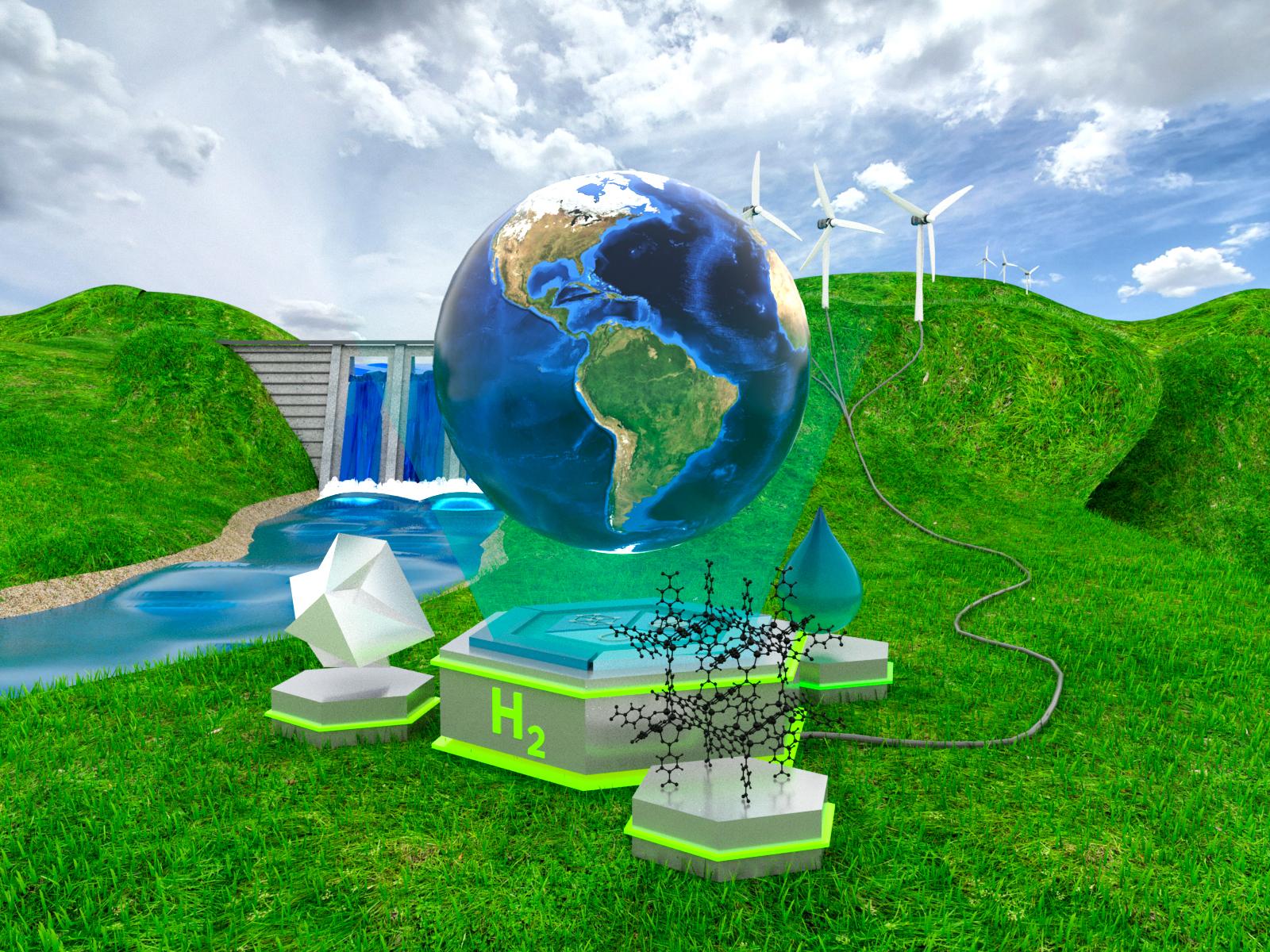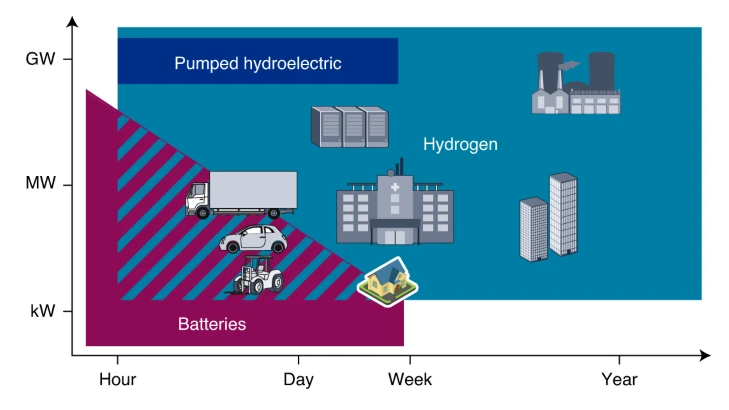Getting Future Hydrogen Storage Solutions Just Right
Like in the classic Goldilocks tale, the best energy storage solutions vary for each real-world application

Hydrogen-based energy storage systems could be used to provide power to a wide range of real-world applications, which is why researchers are working to find the best storage solutions for different uses. In this illustration, the three pillars represent various forms of hydrogen-based energy storage.
(Image by Cortland Johnson | Pacific Northwest National Laboratory)
Hydrogen-based energy storage (HES) systems can be used to power everything, from an individual vehicle to a hospital to the grid, if conditions are just right. HES has the potential flexibility to meet the energy demands of vastly different real-world applications, but like the classic Goldilocks tale, there is no one-size-fits-all solution.
Determining the best HES solution for different applications is key to unlocking the full potential of hydrogen in a carbon neutral future. However, there are very few guidelines available to focus research and development of HES for use in applications like grid storage and industrial decarbonation, which researchers at Pacific Northwest National Laboratory (PNNL) are actively changing.
“How do we start to make hydrogen energy storage systems a reality in more applications? First, we need to establish goalposts for how much energy storage is needed in these different applications. Then we can figure out the best path forward to make those goals a reality and support hydrogen-based energy solutions in more sectors,” said Mark Bowden, a chemist at PNNL.
As part of the Department of Energy’s Hydrogen Materials Advanced Research Consortium (HyMARC), PNNL scientists and their collaborators at Sandia National Laboratories are working to identify where research is needed to bridge the gap between current science and future integration of HES in real-world applications. It comes down to a series of “Goldilocks challenges.”
The Goldilocks challenges
We often face Goldilocks challenges in our daily lives. Need to commute to work every day? A compact, fuel-efficient vehicle would be a good choice. Need to transport an entire soccer team to weekly games? Then you need to prioritize passenger space at the expense of fuel efficiency. How you will use your vehicle helps determine the best option to fit your needs.

Similarly, the Goldilocks challenges for HES involve finding the best storage solution for each intended use. Simply maximizing the total energy stored in every HES system isn’t appropriate for each application because the different kinds of HES have their own strengths and weaknesses.
For example, it’s possible to store hydrogen by chemically binding it to a liquid carrier material, but not just any liquid will do. The bond between the liquid carrier and hydrogen must be sufficiently strong so that hydrogen gas is not lost during long storage periods. But if the bond is too strong, a lot of energy will be required to release the hydrogen when its needed, reducing the overall HES efficiency. Very few compounds are known to strike a good balance between robust storage and energy efficiency.
“To move hydrogen across the country, you’d want a high-density, one-way carrier storage option—like ammonia, methanol, or formic acid—to maximize the amount of energy being transported and stay cost effective. You would not want to have to move the carrier back across the country to regenerate it,” said Tom Autrey, PNNL Laboratory fellow, chemist, and co-author on the publication. “But, this would not necessarily be a concern for local applications, like seasonal microgrid support, that don’t require long-distance transportation. Round-trip HES systems—like ethanol, methylcyclohexane, or aqueous formate—in which you release the hydrogen at times of energy demand and put the hydrogen back at times of excess available energy, are appropriate for such applications.”
That is just one example of the many Goldilocks challenges that face researchers, as detailed in a recent invited perspective publication to Nature Chemistry. To begin overcoming these challenges, researchers need to know what they are working towards—the most appropriate HES for different uses.
Establishing goalposts
The Department of Energy’s Hydrogen Shot, launched in 2021, will accelerate the growth of clean hydrogen over the next decade to make it more accessible and affordable. A key part of this growing hydrogen sector will be appropriate storage options for hydrogen used in different applications. Although there are clear targets for hydrogen storage in vehicles, there are few specific targets to guide HES development in other sectors.
That’s where this work comes in. In this new publication, researchers have outlined the storage criteria for other potential HES applications, including fueling high-speed ferries, providing hospital backup power, and supporting seasonal microgrid storage.
“We provide a valuable piece of the puzzle in this paper by detailing important criteria for HES that will make hydrogen an option for applications like emergency backup power for critical infrastructure or microgrid energy storage, and the potential bottlenecks to overcome in reaching those goals,” explained Bowden. “We hope this information will guide researchers and developers to realistic hydrogen energy storage options for many more real-world applications.”
With the growing investment in HES, these goalposts will play a valuable role informing the direction of future research and development in hydrogen and bring us one step closer to a cleaner energy future.
This work was published as an invited perspective in Nature Chemistry, authored by Mark Allendorf, Vitalie Stavila, Jonathan Snider, and Matthew Witman of Sandia National Laboratories, and Mark Bowden, Kriston Brooks, Ba Tran, and Tom Autrey of PNNL. The research was supported by the Department of Energy’s Hydrogen and Fuel Cell Technologies Office and Hydrogen Materials Advanced Research Consortium.
Published: November 14, 2022